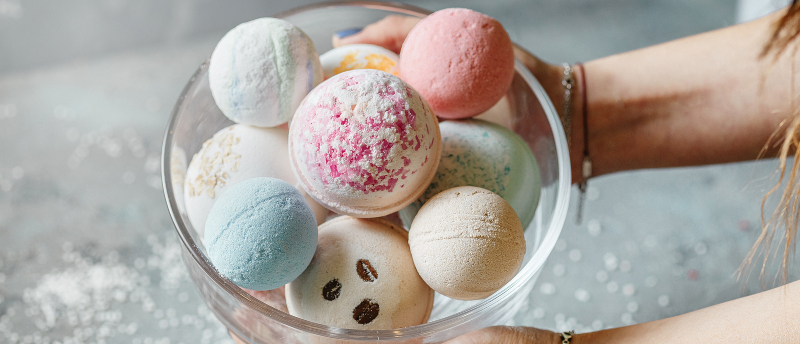How Bath Bombs May Secretly Be Hurting You

Taking a bath has many health benefits. For some, a bath helps relieve stress after a long workday. For others, a warm bath can ease sore muscles after a difficult workout. A 2017 study found that a hot bath can have similar benefits to exercise.
With more people using a warm bath to relax, some companies promote products to enhance the experience. One such product is the "bath bomb." A bath bomb is a compact mold of dried ingredients that fizz with color and soothing aromas once added to a tub full of water.
Although bath bombs can bring fun and color to bath time, there's a hidden ugly truth to the nature of bath bombs. Many of these products contain harmful ingredients that may discourage you from the tub altogether.
We've outlined a few of the ways bath bombs could be secretly hurting you below.
1. Talcum Powder Can Cause Ovarian Cancer
Talcum powder or baby powder is made from the mineral talc. This powder is an ingredient in many common cosmetic products. However, talc has been linked to an increased risk of ovarian cancer. Bath bombs that have talcum powder in them may increase this risk as a woman soaks in the talc-filled bathwater.
Studies going back as far as the 1970s have linked talcum powder to the development of ovarian tumors. Be sure to thoroughly check your bath bomb's ingredients for this potentially carcinogenic ingredient.
2. Perfumes and Dyes Can Cause Vaginal Infections
A slew of good bacteria exists to keep the vagina at a healthy 4 - 4.5 on the pH scale. When manufactured perfumes and dyes from bath bombs are added to the water you're relaxing in, there's a likely chance they will upset these good bacteria. Perfumes or dyes might inhibit the bacteria's efforts to maintain this already delicate pH balance.
Once the pH balance is thrown out of whack, women have an increased risk of developing infections such as vaginosis, urinary tract infections, and even cystitis. Using unscented bath products becomes much more appealing when the potential for infection comes into play.
3. Synthetic Scents May Be Toxic
"Fragrance" is a common ingredient listed on bath bomb packaging. In reality, the term "fragrance" may describe as many as 3,000 unlisted toxins. Some of these toxins may affect your health immediately or lead to long-term health issues.
When using bath bombs, the toxins in synthetic scents can be absorbed by the bloodstream. This can put you at risk for certain health conditions and diseases. Certain toxins may be especially hazardous for pregnant women and children. Some synthetic perfumes have been linked to the development of autism in children.
If you're in need of products that have aromatherapy benefits, look for ones that contain essential oils or other organic ingredients instead. These are likely to be much safer than the synthetic "fragrances" found in some products.
4. Bath Bomb Glitter Is an Environmental Hazard
If you're environmentally conscious, you should know that the glitter found in some bath bombs is made of micro-plastic -- a material that can't be broken down in the environment.
Although it poses no direct personal health threat, it can negatively affect the aquatic species that ingest these non-biodegradable materials. In turn, it may one day affect those of us who are higher up on the food chain, as these animals make up a large part of our regular diets.
Check the Ingredients - Or Make Your Own!
It's obvious that bath bombs are both eye-catching and entertaining for those of us who love bath time. But as the health risks above point out, it may be best to stick to a good old-fashioned bubble bath instead.
However, if you're still itching to see those swirls of color in your tub, try this DIY bath bomb recipe from Popular Science. The recipe uses natural ingredients that won't pose a risk to your health or the environment. Not only will you be able to capture the perfect bath time Instagram, but your body will thank you for choosing a safer option.
